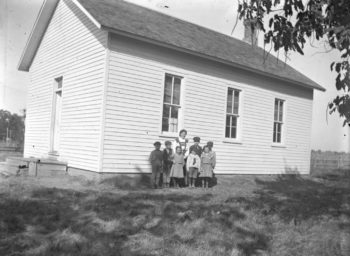
A group portrait of seven rural students with their teacher standing alongside their one-room schoolhouse in Muscatine County in 1910. The clapboard sided building has three tall windows, as well as wooden steps and a porch that lead to a single-wide doorway with a transom window. A field of corn can be seen behind the schoolyard. Photo by Oscar Grossheim. Photo courtesy of Musser Public Library
By Bill Sherman
(Publisher’s note: Part 1 of Iowa History Journal’s special three-part series about Iowa’s country schools is devoted to the history of little schoolhouses on the prairie. Part 2 will focus on education leader Henry Sabin. Part 3 will report on country school preservation and interpretative programs in Iowa.)
One-room country schools once thrived across North America. Just before the outbreak of World War I, most American school children received their early education in them. Educational historian David Tyack estimates that in 1913 there were 215,000 ungraded elementary schools where one teacher was responsible for instructing students in grades one through eight.
Every state had one-room schools. But Iowa was the state that had the most operating one-teacher schools for the longest period of time. The number peaked in 1901 when there were 12,623 such learning centers.
Today, there are fewer than 200 public one-room schools in America still in operation. Seven of them are in Iowa.
The first Iowa school opened in 1830, 16 years before Iowa achieved statehood. Dr. Isaac Galland, a physician who had moved across the Mississippi River into a settlement called Nashville, which later became known as Galland, started it. Galland recruited 20-year-old Berryman Jennings, who had taught in a one-room school in Kentucky, to serve as teacher.
Galland offered Jennings room and board and sweetened the deal by providing him access to his medical library. Parents paid Jennings approximately 50 cents per student, per term and provided him with produce from their farms.
The first school was held in a log cabin that was a home. Eight children attended it. The school was located near the Mississippi River, a few miles north of Keokuk in Lee County. That school no longer exists, but two replicas were constructed. The first, built in 1940, was dismantled. In 1977, a second, more sturdy replacement was created. It is maintained as a museum building in the village of Montrose, located a few miles north of Keokuk on the Great River Road/Highway 61. Amazingly, a student chair made from barrels used in the first Iowa school still survives. It is on display in the Samuel F. Miller House Museum located at 318 N. 5th St. in Keokuk.
TO READ MORE ABOUT THIS STORY AND OTHER FASCINATING STORIES ABOUT IOWA HISTORY, subscribe to Iowa History Journal. You can also purchase back issues at the store.
